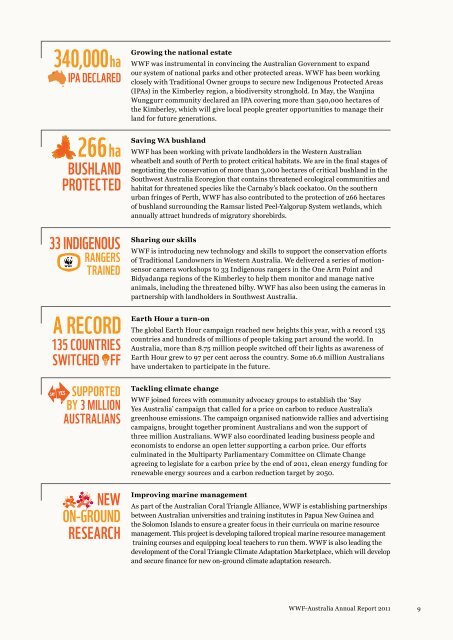WWF-Australia Annual Report 2011
WWF-Australia Annual Report 2011
WWF-Australia Annual Report 2011
You also want an ePaper? Increase the reach of your titles
YUMPU automatically turns print PDFs into web optimized ePapers that Google loves.
340,000ha<br />
IPA declARED<br />
Growing the national estate<br />
<strong>WWF</strong> was instrumental in convincing the <strong>Australia</strong>n Government to expand<br />
our system of national parks and other protected areas. <strong>WWF</strong> has been working<br />
closely with Traditional Owner groups to secure new Indigenous Protected Areas<br />
(IPAs) in the Kimberley region, a biodiversity stronghold. In May, the Wanjina<br />
Wunggurr community declared an IPA covering more than 340,000 hectares of<br />
the Kimberley, which will give local people greater opportunities to manage their<br />
land for future generations.<br />
266 ha<br />
bushland<br />
protECted<br />
33 Indigenous<br />
rangers<br />
tRAinED<br />
Saving WA bushland<br />
<strong>WWF</strong> has been working with private landholders in the Western <strong>Australia</strong>n<br />
wheatbelt and south of Perth to protect critical habitats. We are in the final stages of<br />
negotiating the conservation of more than 3,000 hectares of critical bushland in the<br />
Southwest <strong>Australia</strong> Ecoregion that contains threatened ecological communities and<br />
habitat for threatened species like the Carnaby’s black cockatoo. On the southern<br />
urban fringes of Perth, <strong>WWF</strong> has also contributed to the protection of 266 hectares<br />
of bushland surrounding the Ramsar listed Peel-Yalgorup System wetlands, which<br />
annually attract hundreds of migratory shorebirds.<br />
Sharing our skills<br />
<strong>WWF</strong> is introducing new technology and skills to support the conservation efforts<br />
of Traditional Landowners in Western <strong>Australia</strong>. We delivered a series of motionsensor<br />
camera workshops to 33 Indigenous rangers in the One Arm Point and<br />
Bidyadanga regions of the Kimberley to help them monitor and manage native<br />
animals, including the threatened bilby. <strong>WWF</strong> has also been using the cameras in<br />
partnership with landholders in Southwest <strong>Australia</strong>.<br />
Earth Hour a turn-on<br />
The global Earth Hour campaign reached new heights this year, with a record 135<br />
countries and hundreds of millions of people taking part around the world. In<br />
<strong>Australia</strong>, more than 8.75 million people switched off their lights as awareness of<br />
Earth Hour grew to 97 per cent across the country. Some 16.6 million <strong>Australia</strong>ns<br />
have undertaken to participate in the future.<br />
supportED<br />
by 3 million<br />
austRAlians<br />
Tackling climate change<br />
<strong>WWF</strong> joined forces with community advocacy groups to establish the ‘Say<br />
Yes <strong>Australia</strong>’ campaign that called for a price on carbon to reduce <strong>Australia</strong>’s<br />
greenhouse emissions. The campaign organised nationwide rallies and advertising<br />
campaigns, brought together prominent <strong>Australia</strong>ns and won the support of<br />
three million <strong>Australia</strong>ns. <strong>WWF</strong> also coordinated leading business people and<br />
economists to endorse an open letter supporting a carbon price. Our efforts<br />
culminated in the Multiparty Parliamentary Committee on Climate Change<br />
agreeing to legislate for a carbon price by the end of <strong>2011</strong>, clean energy funding for<br />
renewable energy sources and a carbon reduction target by 2050.<br />
Improving marine management<br />
As part of the <strong>Australia</strong>n Coral Triangle Alliance, <strong>WWF</strong> is establishing partnerships<br />
between <strong>Australia</strong>n universities and training institutes in Papua New Guinea and<br />
the Solomon Islands to ensure a greater focus in their curricula on marine resource<br />
management. This project is developing tailored tropical marine resource management<br />
training courses and equipping local teachers to run them. <strong>WWF</strong> is also leading the<br />
development of the Coral Triangle Climate Adaptation Marketplace, which will develop<br />
and secure finance for new on-ground climate adaptation research.<br />
<strong>WWF</strong>-<strong>Australia</strong> <strong>Annual</strong> <strong>Report</strong> <strong>2011</strong><br />
9

















